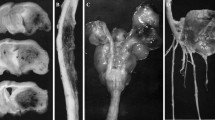Summary
The present investigations showed that assumed and established metabolites of dipropylnitrosamine and dibutylnitrosamine reach the Syrian hamster fetus after subcutaneous (s.c.) treatment of their mothers (at day 14 of gestation). The compounds [2-hydroxypropylpropylnitrosamine, HPPN; 2-oxopropylpropylnitrosamine, OPPN; methylpropylnitrosamine, MPN; N-nitrosobis(2-hydroxypropyl)amine, BHP; and 4-hydroxybutylbutylnitrosamine, HBBN] were still present in the examined tissue (maternal blood, placenta, fetus, amniotic fluid) 4–6 h after s.c. injection. The overall incidence of transplacentally induced tumors was lower in the F1- than in the P-generation and comparatively longer latencies were also observed in the F1-generation. However, in some groups low incidences were found of tumors which did not occur in the mothers (i.e., nasal cavities: BHP, HBBN; trachea: HBBN; lungs: HPPN, BHP, HBBN; liver: OPPN, MPN, BHP, HBBN). Compared to exposure at early gestation, the transplacental carcinogenic effect increased at day 14 of gestation. Neoplasms originating in other organs were not associated with a transplacental effect of the examined nitrosamines.
Zusammenfassung
Die Untersuchungen haben gezeigt, daß angenommene sowie gefundene Metaboliten des Dipropyl- und Dibutylnitrosamins die Feten Syrischer Hamster via Placenta nach subcutaner (s.c.) Behandlung der Muttertiere (14. Tag der Tragzeit) erreichen. Die Verbindungen (2-hydroxypropylpropylnitrosamin, HPPN; 2-oxopropylpropylnitrosamin, OPPN; methylpropylnitrosamin, MPN; N-nitrosobis(2-hydroxypropyl)amin, BHP; 4-hydroxybutylbutylnitrosamin, HBBN) waren noch 4–6 Std nach subcutaner Injektion in den untersuchten Geweben (mütterliches Blut, Placenta, Fetus, Fruchtwasser) nachweisbar. Die allgemeine Tumorhäufigkeit transplacentar induzierter Tumoren war geringer in der F1- als in der P-Generation, während vergleichsweise die Latenzzeiten verlängert waren. Darüber hinaus fanden sich jedoch Geschwülste in geringer Häufigkeit bei einigen Gruppen, die bei Muttertieren nicht gefunden wurden (Nasenhöhle: BHP, HBBN; Trachea: HBBN; Lunge: HPPN, BHP, HBBN; Leber: OPPN, MPN, BHP, HBBN). Für den Laryngo-Tracheal-Trakt erhöhte sich die transplacentare carcinogene Wirkung nach Behandlung am 14. Tag der Tragzeit in Vergleich zur Exposition an einem früheren Zeitpunkt der Gestation. Tumoren anderer Organe wurden nicht auf eine transplacentare Wirkung der untersuchten Nitrosamine bezogen.
Similar content being viewed by others
References
Althoff,J., Grandjean,C., Marsh,S., Pour,P., Takahashi,M.: Transplacental effects of nitrosamines in Syrian hamsters. II. Nitrosopiperidine. Z. Krebsforsch, (in press)
Althoff,J., Krüger,F.W.: Carcinogenicity of 4-hydroxybutylbutylnitrosamine in Syrian hamsters. Cancer Letters 1, 15–19 (1975)
Althoff,J., Krüger,F.W., Mohr,U., Schmähl,D.: Dibutylnitrosamine carcinogenesis in Syrian golden and Chinese hamsters. Proc. Soc. Exp. Biol. Med. 136, 168–173 (1971)
Althoff,J., Pour,P., Grandjean,C., Marsh,S.: Transplacental effects of nitrosamines in Syrian hamsters. III. Dimethyl- and dipropylnitrosamine. Z. Krebsforsch, (in press)
Althoff,J., Pour,P., Grandjean,C., Eagen,M.: Transplacental effects of nitrosamines in Syrian hamsters. I. Dibutylnitrosamine and nitrosohexamethyleneimine. Z. Krebsforsch. 86, 69–75 (1976)
Druckrey,H., Preussmann,R., Ivankovic,S., Schmidt,C.H., Mennel,H.D., Stahl,K.W.: Selektive Erzeugung von Blasenkrebs an Ratten durch Dibutyl- und N-Butyl-N-butanol(4)-nitrosamin. Z. Krebsforsch. 66, 280–290 (1964)
Druckrey,H., Preussmann,R., Ivankovic,S., Schmähl,D.: Organotrope carcinogene Wirkungen bei 65 verschiedenen N-Nitrosoverbindungen an BD-Ratten. Z. Krebsforsch. 69, 103–201 (1967)
Ivankovic,S.: Pränatale Carcinogenese. Handbuch der allgemeinen Pathologie, 6. Band, GeschwülsteTumore 3, 7. Teil. Berlin: Springer 1976
Ivankovic,S., Bücheler,J.: Leber- und Blasencarcinome beim Meerschweinchen nach Di-n-butylnitrosamin. Z. Krebsforsch. 71, 183–185 (1968)
Krüger,F.W., Pour,P., Althoff,J.: Induction of pancreas tumors by di-iso-propanolnitrosamine. Naturwissenschaften 61, 328 (1974)
Mohr,U., Althoff,J., Authaler,A.: Diaplacental effect of the carcinogen diethylnitrosamine in the golden hamster. Cancer Res. 26, 2349–2352 (1966)
Mohr,U., Authaler,A., Althoff,J.: Der Nachweis von Diäthylnitrosamin in Goldhamsterembryonen nach Behandlung des Muttertieres. Naturwissenschaften 52, 188–189 (1965)
Mohr,U., Reznik-Schüller,H., Reznik,G., Hilfrich,J.: Transplacental effects of diethylnitrosamine in Syrian hamsters as related to different days of administration during pregnancy. J. Natl. Cancer Inst. 55, 681–685 (1975)
Pour,P., Althoff,J., Cardesa,A., Krüger,F.W., Mohr,U.: Effect of β-oxidized nitrosamines on Syrian golden hamsters. II. 2-Oxopropyl-n-propylnitrosamine. J. Natl. Cancer Inst. 52, 1869–1874 (1974)
Pour,P., Kmoch,N., Greiser,E., Mohr,U., Althoff,J., Cardesa,A.: Spontaneous tumors and common diseases in two colonies of Syrian hamsters. I. Incidence and sites. J. Natl. Cancer Inst. 56, 931–935 (1976)
Pour,P., Krüger,F.W., Althoff,J., Cardesa,A., Mohr,U.: Effect of β-oxidized nitrosamines in Syrian golden hamsters. I. 2-Hydroxypropyl-n-propylnitrosamine. J. Natl. Cancer Inst. 52, 1245–1249 (1974)
Pour,P., Krüger,F.W., Cardesa,A., Althoff,J., Mohr,U.: Carcinogenic effect of di-n-propylnitrosamine in Syrian golden hamsters. J. Natl. Cancer Inst. 51, 1019–1027 (1973)
Pour,P., Krüger,F.W., Cardesa,A., Althoff,J., Mohr,U.: Tumorigenicity of methyl-n-propylnitrosamine in Syrian golden hamsters. J. Natl. Cancer Inst. 52, 457–462 (1974)
Tomatis,L.: Transplacental carcinogenesis. Oncology, Vol 1, p.5. London: Butterworth 1973
Wood,M., Flaks,A., Clayson,D.B.: The carcinogenic activity of dibutylnitrosamine in IFXC57 mice. Europ.J. Cancer 6, 433–440 (1970)
Author information
Authors and Affiliations
Additional information
Supported by U.S. Public Health Service Contract NO1 CP33278 from the Division of Cancer Cause and Prevention, National Cancer Institute
We thank Nancy Hays for technical assistance and Mardelle Susman for editorial aid.
Rights and permissions
About this article
Cite this article
Althoff, J., Grandjean, C. & Pour, P. Transplacental effect of nitrosamines in Syrian hamsters. Z. Krebsforsch. 90, 119–126 (1977). https://doi.org/10.1007/BF00285318
Received:
Accepted:
Issue Date:
DOI: https://doi.org/10.1007/BF00285318



